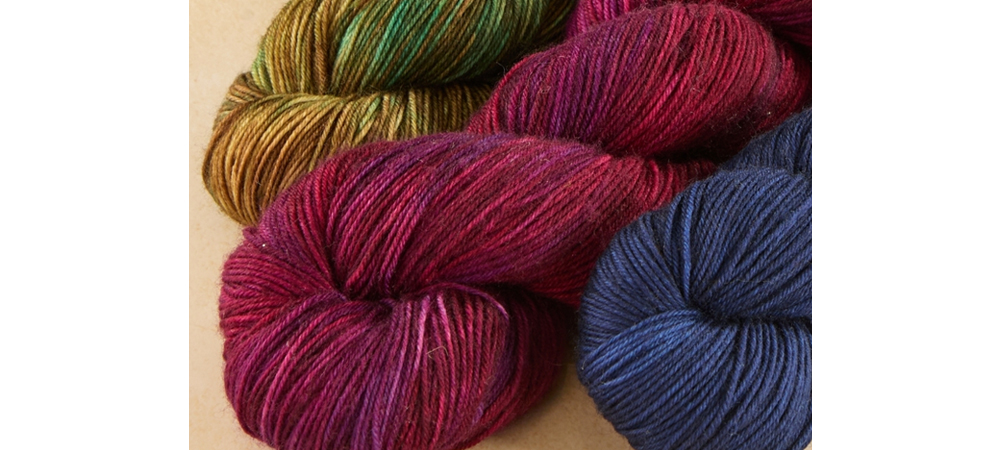Getting Familiar with Yarn
- Blog Views : 155
- Symfonie Yarns
- 28Aug, 2024

When someone first begins to knit and crochet, there is a learning curve to master. It starts with an interest in handicrafts, respect for hard work and a desire to be creative. Learning is often like falling in love if you take to the craft. You start out with enthusiasm and a willingness to understand, and as time goes by, you discover what works best for you, adapt, and watch your relationship with the craft flourish.
Often, what brings someone to needle crafts is the love of the material. Yarn is what shapes up your project. You can start with fluffy wool, opt for polyamide blends and even try for elegant silk. There’s a lot to experiment with merino wool, cashmere, alpaca, cotton, linen, bamboo and other man-made varieties. In short, you really like yarn, so let’s start there. Basically, these are the most often used yarn weights: Fingering, DK, Worsted, Aran, Bulky, and Jumbo. While there are variations of each, these are the types you most frequently see in-store, online, and named in patterns. To know more about yarn weight in detail, check out our yarn weights: complete guide for beginners.
How to Choose the Right Yarn for Your Project?
After one learns the “basics” – knitting and purling – the fun really begins. The first undertaking usually involves something simple like a scarf or a baby blanket. Choosing the right yarn for the project can be daunting, but it doesn’t have to be. Having the proper support is a huge help, but since not everyone has a local yarn store nearby, here are some things to keep in mind.

High-Quality - First, honor your work and time by using premium-quality yarn. If the project is meant to be worn near the skin, you should consider a soft yarn for garments such as a scarf or hat.
For socks, a fingering-weight yarn containing washable wool would be ideal. Since any garment or item worn or used often is sure to require frequent cleaning, it’s best that it is easy to maintain. Machine washable wools are ideal for things like socks, scarves, and blankets. They also are good for baby and children’s wear for obvious reasons.
Safe and Skin Friendly - You might also check to see that the yarn is safe to wear next to the skin (the Oekotex Class 100 certification is a guarantee.) This is really important for anything made for babies and children. Wool yarn is always a great choice since it’s warm and perfect for items that are meant to keep us protected from drafts and the cold. (Synthetics have zero ability to keep any person or creature warm.)
Colors - Next, consider color. It’s smart to use a color you really like since it is more fun to work on something that is pleasing to your eye and taste. Finding the right color yarn is easy enough these days thanks to the internet. And, it is not just semi-solid colors there are so many color combinations of variegated yarns.
Hand-dyed yarns are often the most beautiful since care is taken to come up with color and tones that are unique. It’s also a way to make sure that your work stands out from the crowd. If you are looking online, check out Symfonie’s curated yarn collection and see what comes up. Variegated yarns are also worthy of investigation. When complementary colors are blended, the result is often a study of happy contrasts that catch the eye. If you purchase a skein of yarn in variegated shades, make sure to swatch it up before beginning your project so you can see how the colors look when knitted or crocheted. That way you can gauge how to show the yarn at its best advantage.
Deciding on Yarns and Knitting Projects
Socks are often made with variegated yarns that benefit from a variety of colors. The same is true for hats. Semisolid hand-dyed yarns in a single shade or with colorwork also do wonderfully. Terra range fits the needs of the project perfectly. The merino-polyamide blend.
If you decide to make a small throw or baby blanket, it’s wise to select a machine washable yarn in merino wool. Wool for warmth and washable for easy maintenance. Another attractive fact about the washable yarn is that it will not felt – making sure the item retains its suppleness and the stitch definition that says “hand-knit” or “hand-crocheted”. DK yarns such as Viva are a good choice. The mid-weight yarn range is a good fit for almost every type of project imaginable. But, it’s amazing for sweaters, cardigans and shawls.
For a blanket or throw, you might consider using a worsted-weight yarn. A slightly bulky yarn variety Bella Yarns are a wonderful option. It is soft, machine washable and is available in a wide range of color options. Worsted weight is a bit heavier than DK weight yarn, but just weighty enough to impart a sense of “coziness” without being overwhelming. It is also a great crochet yarn, which is why you often see it used for baby blankets or afghans. Many new knitters like using the yarn weight since it is worked on medium-sized needles (US:7 or 8/4.5;5.0mm) or crochet hooks (US: G or H/ 4.5;5.0mm) and finishes up faster.
There’s nothing like quick gratification to ensure a “maker” comes back for more.
In our next installment on Yarn Varieties, we will look at the wonderful world of Bulky and Jumbo yarns. Be sure to come back for more!
-
- 23 Apr,2025
-
- 19 Apr,2025
-
- 14 Apr,2025
-
- 10 Apr,2025
-
- 07 Apr,2025
-
- 04 Apr,2025
Copyright © Symfonie Yarns 2025 - all rights reserved | RSS Feed
